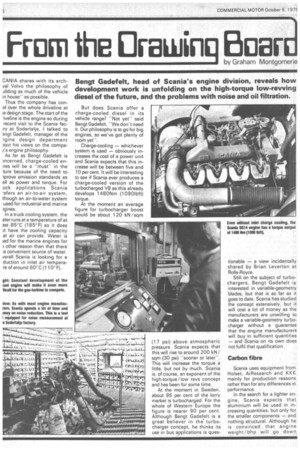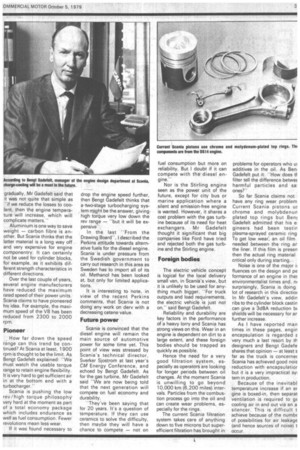From the Orekkil11 Boar
Page 38

Page 39

If you've noticed an error in this article please click here to report it so we can fix it.
by Graham Montgomerie Bengt Gadefelt, head of Scania's engine division, reveals how development work is unfolding on the high-torque low-revving diesel of the future, and the problems with noise and oil filtration.
CANIA shares with its archval Volvo the philosophy of !ding as much of the vehicle in house" as possible.
Thus the company has conol over the whole driveline at le design stage. The start of the -iveline is the engine so during recent visit to the Scania faciry at Sodertalje, I talked to engt Gadefelt, manager of the -igine design department )(Jut his views on the compa(s engine philosophy.
As far as Bengt Gadefelt is )ncernecl, charge-cooled ennes will be a "must" in the ture because of the need to. -prove emission standards as ell as power and torque. For uck applications Scania 'efers an air-to-air system, though an air-to-water system used for industrial and marine In a truck cooling system, the ater runs at a temperature of at ast 85cC (185'F) so it does )t have the cooling capacity at air can provide. Water is ;ed for the marine engines for ) other reason than that there. a convenient source of water. verall Scania is looking for a duction in inlet air temperare of around 60'C (110°F).
But does Scania offer a charge-cooled diesel in its vehicle range? "Not yet" said Bengt Gadefelt. "We don't need it. Our philosophy is to go for big engines, so we've got plenty of room yet".
Charge-cooling — whichever system is used — obviously increases the cost of a power unit and Scania expects that this increase will be between five and 10 per cent. It will be interesting to see if Scania ever produces a charge-cooled version of the turbocharged V8 as this already develops 1480Nm (10901bft) torque.
At the moment an average figure for turbocharger boost would be about 120 kN /sqm (1 7 psi) above atmospheric pressure. Scania expects that this will rise to around 200 kN / sqm (30 psi) "sooner or later". This will increase the torque a little, but not by much. Scania is, of course, an exponent of the high-torque/ low revs concept and has been for some time.
At the moment in Sweden, about 95 per cent of the lorry market is turbocharged. For the whole of Western Europe the figure is nearer 90 per cent. Although Bengt Gadefelt is a great believer in the turbocharger concept, he thinks its use in bus applications is ques tionable — a view incidentally shared by Brian Leverton at Rolls-Royce.
Still on the subject of turbochargers, Bengt Gadefelt is interested in variable-geometry blades, but that is as far as it goes to date. Scania has studied the concept extensively, but it will cost a lot of money as the manufacturers are unwilling to make a variable-geometry turbocharger without a guarantee that the engine manufacturers will buy in sufficient quantities — and Scania on its own does not fulfil that qualification.
Carbon fibre
Scania uses equipment from Holset, AiResearch and KKK mainly for production reasons rather than for any differences in performance. In the search for a lighter engine, Scania expects that aluminium will be used in increasing quantities, but only for the smaller components — and nothing structural. Although he is convinced that engine weight/bhp will go down gradually, Mr Gadefelt said that it was not quite that simple as "if we reduce the losses to coolant, then the engine temperature will increase, which will complicate matters."
Aluminium is one way to save weight — carbon fibre is another. But Scania thinks that the latter material is a long way off and very expensive for engine componentry. It can certainly not be used for cylinder blocks, for example, as it exhibits different strength characteristics in different directions.
Over the last couple of years, several engine manufacturers have reduced the maximum rated speed of their power units. Scania claims to have pioneered his idea. For example, the maximum speed of the V8 has been reduced from 2300 to 2000 rpm.
Pioneer
, How far down the speed range can this trend be continued? At Scania at least, 1900 rpm is thought to be the limit. As Bengt Gadefelt explained: "We Must watch the usable torque range to retain engine flexibility. It is very hard to get sufficient air in at the bottom end with a turbocharger."' Scania is pushing the low rev/high torque philosophy very hard at the moment as part of a total economy package which includes endurance as well as fuel consumption. Fewer revolutions mean less wear.
If it was found necessary to drop the engine speed further, then Bengt Gadefelt thinks that a two-stage turbocharging system might be the answer, giving. high torque very low down the rev range — "but it will be expensive".
In the last -From the Drawing Board", I described the Perkins attitude towards alternative fuels for the diesel engine. Scania is under pressure from the Swedish government to carry out research in this area as Sweden has to import all of its oil. Methanol has been looked at, but only for limited applications.
It is interesting to note, in view of the recent Perkins comments, that Scania is not doing any work on dery with a decreasing cetane value.
Future power •
Scania is convinced that the diesel engine will remain the main source of automotive power for some time yet. This point of view was stressed by Scania's technical director, Sverker Sjostrom at last year's CM Energy Conference, and echoed by Bengt Gadefelt. As for the gas turbine, Mr Gadefelt said "We are now being told that the next generation will compete on fuel economy and durability.
-They've been saying that for 20 years. It's a question of temperature. If they can use ceramics to solve the difficulty, then maybe they will have a chance to compete — not on
fuel consumption but more on reliability. But I doubt if it can compete with the diesel engine."
Nor is the Stirling engine seen as the power unit of the future, except for city bus or marine application where a silent and emission-free engine is wanted. However, it shares a cost problem with the gas turbine because of its need for heat exchangers. Mr Gadefelt thought it significant that big companies like Ford have tried and rejected both the gas turbine and the Stirling engine.
Foreign bodies
The electric vehicle concept is logical for the local delivery small van, in Scania's view, but it is unlikely to be used for anything much bigger. "For truck outputs and load requirements, the electric vehicle is just not on," said Bengt Gadefelt.
Reliability and durability are key factors in the performance of a heavy lorry and Scania has strong views on this. Wear in an engine is dependent on dirt to a large extent, and these foreign bodies should be trapped as quickly as possible.
Hence the need for a very good filtration system, especially as operators are looking for longer periods between oil changes. At the moment Scania is unwilling to go beyond 10,000 km (6,200 miles) intervals. Particles from the combustion process go into the oil and can create wear problems, especially for the rings.
The current Scania filtration system takes care of anything down to five microns but superefficient filtration has brought in problems for operators who ui additives in the oil. As Ben. Gadefelt put it. "How does th filter tell the difference betweE harmful particles and sa ones?"
So far Scania claims not have any ring wear problem Current Scania pistons ue chrome and molybdenun plated top rings but Beni Gadefelt admitted that his ei gineers had been testin plasma-sprayed ceramic ring To get low wear', an oil film needed between the ring ar the liner. If this film is presen then the actual ring material critical only during starting.
Noise is one of the major ii fluences on the design and pe formance of an engine in thee environmentalist times and, ni surprisingly, Scania is doing lot of research in this directioi In Mr Gadefelt's view, addin ribs to the cylinder block castin can give a 3dBA reduction lot shields will be necessary for ar further increase.
As I have reported man times in these pages, engin encapsulation is regarded e very much a last resort by th designers and Bengt Gadefe shares that opinion — at least s far as the truck is concernec Scania has achieved good nois reduction with encapsulatior but it is a very impractical Sy: tem in production.
Because of the inevitabl temperature increase if an er gine is boxed-in, then separat ventilation is required to gE cooling air in and out via an a silencer. This is difficult t achieve because of the numbE of possibilities for air leakage (and hence sources of noise) t
Occur.




























































































































































